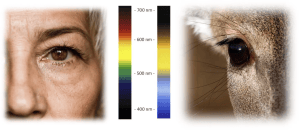Many animals hide from others for a number of reasons. Some hide from predators; others keep themselves hidden from potential prey until the very last moment. No matter the reason, they do so through a technique called camouflage.
Camouflage allows animals to hide by blending in with their surroundings, usually through coloring/markings. There are four main types of camouflage: concealing coloration, disruptive coloration, disguise and mimicry.
An animal will conceal its colors to blend in with its surroundings, while disruptive coloration takes the form of stripes or spots to break up the outline. Some animals will disguise themselves as part of their surroundings – making themselves look like leaves, flowers, tree bark, etc. And mimicry is when an animal mimics the appearance of different one that is either poisonous or venomous.
Many of our animals here at Turpentine Creek have camouflage, including our very own tigers!
Camouflage in Tigers
Tigers are ambush predators, which means that they will stalk as close to their prey as possible before attacking. Because they rely on stealth, camouflage is crucial. They use both concealing and disruptive coloration to blend in.
A tiger’s orange coat actually blends in with its surroundings! Color cones are structures in the eyes that detect colors. Most mammals only have two – blue and green – which allow them to distinguish between blue and yellow, or violet and green. This is called dichromatic vision. Primates like humans, on the other hand, have trichromatic vision – we have a third, red cone that lets us tell apart red from green.

How does this translate to orange fur giving tigers excellent camouflage? Well, mammals with dichromatic vision can’t tell red apart from green. And this includes tigers themselves as well as their preferred prey, deer. To them, the orange blends right in with the green foliage.
But what about those dark stripes? How do they translate to camouflage? Well, that is where the disruptive coloration comes in. Those stripes do an excellent job at breaking up their silhouette, making it more difficult to pick them out when they are hidden among leaves or bushes. It may be difficult for us to pick up on that when we see a single tiger laying in the short grass, but there are times when this outline disruption is noticeable.
If you’ve ever taken one of our tram tours, chances are that the three tigers Rosie, DOJ and Jinx will be hiding in the corner behind the river cane. It can be really difficult to pick them out from behind all those leaves, even with their orange fur. And if they are cuddled in a pile, it can be difficult to even tell how many tigers are there, let alone pick out the individual tigers.
![]()
Camouflage is an important adaptation that lets animals blend in with their environment. This includes our animals here at TCWR.
Sources:
Figure 1: https://www.outdoorlife.com/hunting/what-colors-can-deer-see/
https://www.reconnectwithnature.org/news-events/big-features/these-animals-are-masters-of-camouflage/
https://www.nih.gov/news-events/nih-research-matters/new-color-vision-pathway-unveiled#:~:text=There%20are%202%20types%20of,%2C%20green%2C%20and%20blue%20light.
https://www.lionstigersandbears.org/the-art-of-camouflage-in-the-tigers-world/
*Published by Eryn Meeker on 11/2/2024*